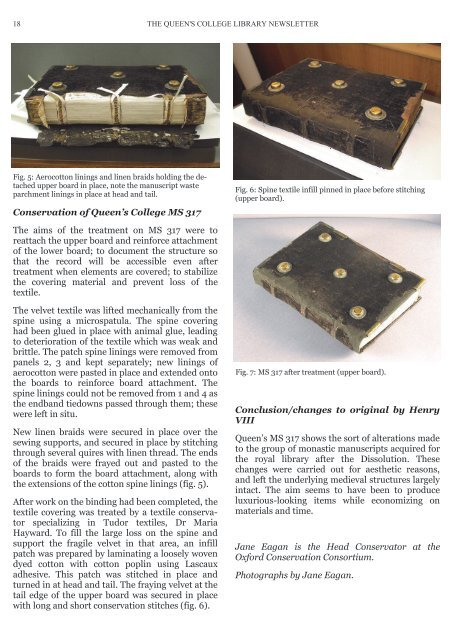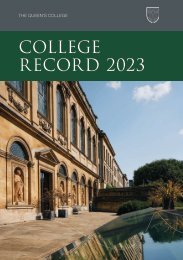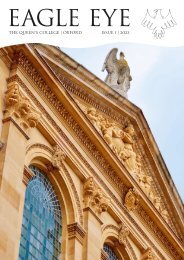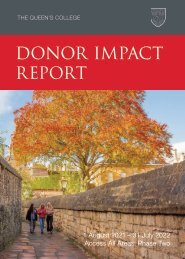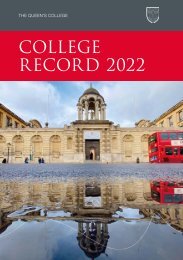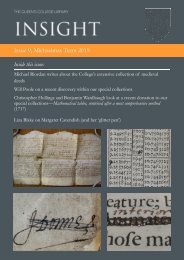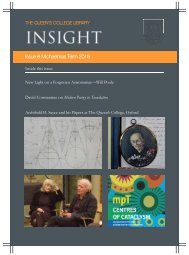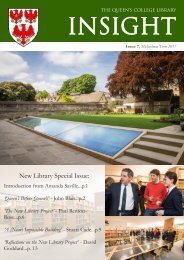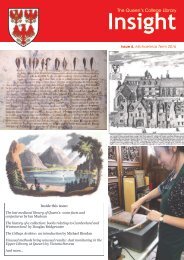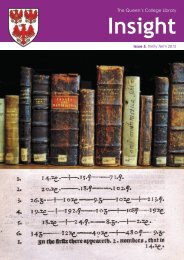Create successful ePaper yourself
Turn your PDF publications into a flip-book with our unique Google optimized e-Paper software.
18<br />
THE QUEEN'S COLLEGE LIBRARY NEWSLETTER<br />
Fig. 5: Aerocotton linings and linen braids holding the detached<br />
upper board in place, note the manuscript waste<br />
parchment linings in place at head and tail.<br />
Conservation of Queen’s College MS 317<br />
Fig. 6: Spine textile infill pinned in place before stitching<br />
(upper board).<br />
The aims of the treatment on MS 317 were to<br />
reattach the upper board and reinforce attachment<br />
of the lower board; to document the structure so<br />
that the record will be accessible even after<br />
treatment when elements are covered; to stabilize<br />
the covering material and prevent loss of the<br />
textile.<br />
The velvet textile was lifted mechanically from the<br />
spine using a microspatula. The spine covering<br />
had been glued in place with animal glue, leading<br />
to deterioration of the textile which was weak and<br />
brittle. The patch spine linings were removed from<br />
panels 2, 3 and kept separately; new linings of<br />
aerocotton were pasted in place and extended onto<br />
the boards to reinforce board attachment. The<br />
spine linings could not be removed from 1 and 4 as<br />
the endband tiedowns passed through them; these<br />
were left in situ.<br />
New linen braids were secured in place over the<br />
sewing supports, and secured in place by stitching<br />
through several quires with linen thread. The ends<br />
of the braids were frayed out and pasted to the<br />
boards to form the board attachment, along with<br />
the extensions of the cotton spine linings (fig. 5).<br />
After work on the binding had been completed, the<br />
textile covering was treated by a textile conservator<br />
specializing in Tudor textiles, Dr Maria<br />
Hayward. To fill the large loss on the spine and<br />
support the fragile velvet in that area, an infill<br />
patch was prepared by laminating a loosely woven<br />
dyed cotton with cotton poplin using Lascaux<br />
adhesive. This patch was stitched in place and<br />
turned in at head and tail. The fraying velvet at the<br />
tail edge of the upper board was secured in place<br />
with long and short conservation stitches (fig. 6).<br />
Fig. 7: MS 317 after treatment (upper board).<br />
Conclusion/changes to original by Henry<br />
VIII<br />
Queen’s MS 317 shows the sort of alterations made<br />
to the group of monastic manuscripts acquired for<br />
the royal library after the Dissolution. These<br />
changes were carried out for aesthetic reasons,<br />
and left the underlying medieval structures largely<br />
intact. The aim seems to have been to produce<br />
luxurious-looking items while economizing on<br />
materials and time.<br />
Jane Eagan is the Head Conservator at the<br />
Oxford Conservation Consortium.<br />
Photographs by Jane Eagan.


